#British art 1945
Explore tagged Tumblr posts
Text
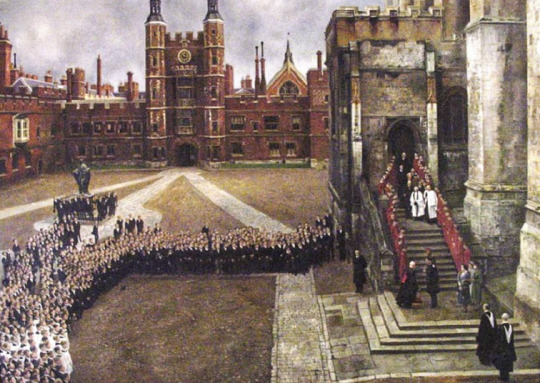
His Majesty King George VI conferring the Order of Knighthood upon Sir Henry Marten, Provost, on the steps of College Chapel
by Richard Eurich // oil on canvas, 1945-6.
Sir Clarence Henry Kennett Marten KCVO was appointed tutor to Princess Elizabeth in 1938, specifically to teach her constitutional history and theory.
AN ETON CEREMONY (March 4, 1945) // British Pathé
#King George VI#Queen Elizabeth II#Queen Mother#Princess Margaret#1945#1940s#British Royal Family#video#art
23 notes
·
View notes
Text

Leonora Carrington Les Distractions de Dagobert
Signed Carrington and dated 1945, September (lower right). Tempera on Masonite. Executed in 1945.
The Surrealist painting by Leonora Carrington (1917–2011) fetched $28.5 million (including fees) at Sotheby’s in New York, setting a new auction record for the British artist.
#Leonora Carrington#Leonora Carrington Les Distractions de Dagobert 1945#british artist#painter#painting#tempera on masonite#art#artist#art work#art world#art news#women in art
12 notes
·
View notes
Text

Royal Canadian Air Force, Marine Section, Patricia Bay, British Columbia insignia, 1945
#illustration#reproduction#wwii#insignia#huey dewey and louie#disney#royal canadian air force#rcaf#marine section#patricia bay#british columbia#1945#fan art#fifteenth in a series
6 notes
·
View notes
Text

Anthony Amies (British, 1945-2000), Landscape with Pylons, c.1973-75. Oil on canvas, 189 x 189 cm. UCL Art Museum, London
4K notes
·
View notes
Text

The Deceitfulness of Riches
Artist: Eleanor Fortescue-Brickdale (British, 1872-1945)
Date: 1901
Medium: Oil on canvas
Collection: Private collection
Description
This painting was first exhibited in 1901 at the Royal Academy, and in 1902 at Leighton House in an exhibition entitled Such Stuff as Dreams are made of (a loose quotation from Shakespeare's The Tempest)
When first displayed, there was much debate as to the meaning of the allegory. An article in the 1902 Magazine of Art offered this interpretation: “A mighty princess, clothed in orange garments, is pictured for us so closely guarded by jealous attendants as to be shut out altogether from the outside world. No harsh breath from the common air may touch the lady's cheek. The orphan and the widow are turned from her gates in order that she may not look upon the face of sorrow. Not willingly hard or callous is this prisoner of a luxurious place, only oblivious from force of circumstances. … The Deceitfulness of Riches is a lay sermon on the tyranny of soft environment and on the unwitting cruelty which lurks in ignorance”
Described by critics as a “Pre-Raphaelite revivalist”, Fortescue-Brickdale was famous for her meticulous techniques and luminous colors. Oxford professor Henry Scott Holland commented on a watercolors exhibition by the artist: “Color? The room glows with it, as if it were flung out of live jewels. The flaming crimsons, the crisp greens, the sheen of rose, speak and sing out of their frames; and you find yourself laughing aloud unawares, for sheer delight, in response. The pictures recall the small gems that Rossetti painted … They are vivid and delicate like young Millais' Ferdinand”.
#painting#allegory#pre raphaelite movement#oil on canvas#british culture#british art#fine art#oil painting#artwork#allegorical scene#allegorical characters#deceit#richness#garden#roses#orange tree#female figures#male figures#color#vibrancy#costume#eleanor fortescue brickdale#british painter#european art#pre raphaelite style#princess#attendants#early 20th century
56 notes
·
View notes
Text

Eleanor Fortescue-Brickdale (British, 1872–1945) • The Little Foot-Page • 1905 • Walker Art Gallery, Liverpool, England
The work is based on the story of Burd Helen, a tragic heroine from Scottish balladry, who dressed as a boy page to follow her cruel lover on foot while he rode on horseback. After bearing him a child, she was finally acknowledged by him and they married. Here she is shown secretly doffing her female attire and cutting her long hair, in preparation for her journey. Within a few years of the exhibition, modern female art students were cutting their hair in "page boy" style.
#eleanor fortescuee brickdale#illustration#art#sassafras & moonshine blog#artwork#pageboy#pre raphaelism#painter#woman artist#british artist#victorian art#early 20th century art#british painter#illustrator#scottish balad
146 notes
·
View notes
Text
Rewind the Tape —Episode 1
Art of the episode
During our rewatch, we took note of the art shown and mentioned in the pilot, and we wanted to share. Did we miss any? Do you have any thoughts about how these references could be interpreted? How do you think Armand and Louis go about picking the art for their penthouse in Dubai?

The Fall of the Rebel Angels
Peter Bruegel the Elder, 1562
This painting is featured in the Interview with the Vampire book, and it was important enough to be included in the draft pilot script!

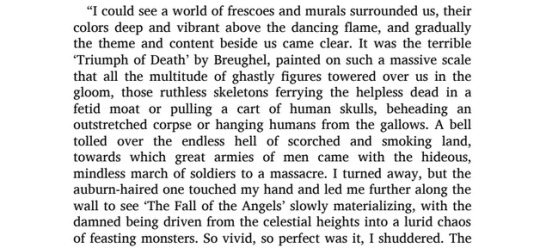
Bruegel the Elder was among the most significant Dutch and Flemish Renaissance artists. He was a painter and print-maker, known for his landscapes and peasant scenes.

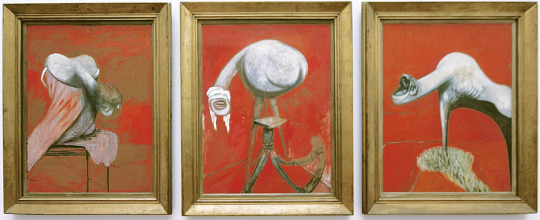
Three Studies for Figures at the Base of a Crucifixion
Francis Bacon, 1944
Bacon was an Irish figurative painter, known for his raw, unsettling imagery and a number of triptychs and diptychs among his work. At a time when being gay was a criminal offense, Bacon was open about his sexuality, and was cast out by his family at 16 for this reason. He destroyed many of his early works, but about 590 still survive. The Tate, where these paintings are displayed, says this about the work: "Francis Bacon titled this work after the figures often featured in Christian paintings witnessing the death of Jesus. But he said the creatures represented the avenging Furies from Greek mythology. The Furies punish those who go against the natural order. In Aeschylus’s tragedy The Eumenides, for example, they pursue a man who has murdered his mother. Bacon first exhibited this painting in April 1945, towards the end of the Second World War. For some, it reflects the horror of the war and the Holocaust in a world lacking guiding principles."

On the Hunt or Captain Percy Williams On A Favorite Irish Hunter and Calling the Hounds Out of Cover
Samuel Sidney, 1881 [Identified by @vfevermillion.] and Heywood Hardy, 1906 [Identified by @destinationdartboard.]
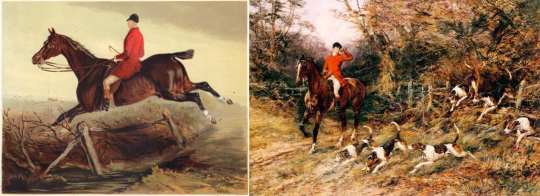
Sidney was an English writer, and his prints usually accompanied his publications about hunting, agriculture, and about settling Australia during the colonial period. Hardy, also British, was a painter, in particular an animal painter. There's also a taxidermy deer, ram, and piebald deer on the wall.
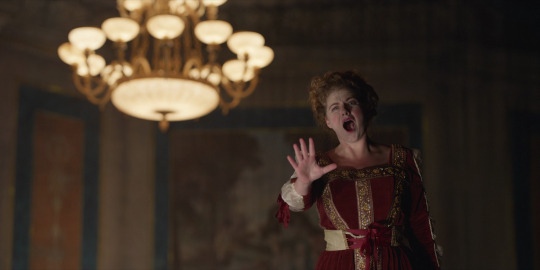
Iolanta
Pyotr Tchaikovsky, 1892
The opera Louis and Lestat go to was composed by Tchaikovsky, another gay artist. The play tells a story "in which love prevails, light shines for all, lies are no longer necessary and no one must fear punishment," as put by Susanne Stähr for the Berliner Philharmoniker.

Strawberries and Cream
Raphaelle Peale, 1816 [Identified by @diasdelfuego.]
Peale is considered to have been the first professional American painter of still-life.

Outfits inspired by J.C. Leyendecker
Leyendecker was one of the most prominent and commercially successful freelance artists in the U.S. He studied in France, and was a pioneer of the Art Deco illustration. Leyendecker's model, Charles Beach, was also his lover of five decades. You can read costume designer Carol Cutshall's thoughts on these outfits on her Instagram.

The Artist's Sister, Melanie
Egon Schiele, 1908 [Identified by @dwreader.]
Schiele was an Austrian expressionist painter and protege of Gustav Klimt. Many of his portraits (self portraits and of others) were described as grotesque and disturbing.
A Stag at Sharkey's
George Wesley Bellows, 1909 [Identified by @vfevermillion.]
Bellows was an American realist painter, known for his bold depictions of urban life in New York City.

Mildred-O Hat
Robert Henri, undated (likely 1890s) [Identified by @nicodelenfent, here.]
Henri was an American painter who studied in Paris, where he learned from the Impressionists and determined to lead an even more dramatic revolt against American academic art.
Starry night
Edvard Munch, 1893 [Identified by @vfevermillion.]
Munch was a Norwegian painter, one of the best known figures of late 19th-century Symbolism and a great influence in German Expressionism in the early 20th century. His work dealt with psychological themes, and he personally struggled with mental illness.
If you spot or put a name to any other references, let us know if you'd like us to add them with credit to the post!
Starting tonight, we will be rewatching and discussing Episode 2, ...After the Phantoms of Your Former Self. We hope to see you there!
And, if you're just getting caught up, learn all about our group rewatch here ►
#louis de pointe du lac#daniel molloy#lestat de lioncourt#vampterview#interview with the vampire#iwtv#amc interview with the vampire#interview with the vampire amc#amc iwtv#iwtv amc#IWTVfanevents#rewind the tape#in throes of increasing wonder#analysis and meta#art of the episode
97 notes
·
View notes
Text






























portrayals of bats in the 20th & 21st centuries
Bat Cabaret Sign - France - wrought iron, rolled iron, carved and embossed, green glass
pair of bats - ivory seal - China
Rene Lalique (French, 1860-1945) - bat brooch - 1900
bat design - Bijutsukai (Art World) - vol. 2 - 1901-1902
Rene Lalique (French, 1860-1945) - bat ring - 1901
Rene Lalique (French, 1860-1945) - bat pendant - 1901
Ferdinand Erhart (French, active 1891-1933) - Bat Belt Buckle - cast silver, carved and oxidized - 1908
Bat Brooch - France - c.1908
Henri Husson (French, 1852-1933) - Cup with Bat - c.1909
Ohara Koson (Japanese, 1877-1945) - Bats In Moonlight - c.1910
Harrison Cady (American, 1877-1970) - illustration for Mother West Wind Why Stories by Thornton Burgess - 1915
John Buckland Wright (British, 1897-1954) - illustration for Le Sphinx by Iwan Gilkin - 1919
Heinrich Kley (German, 1863-1945) - illustration for Der Orchideengarten (The Orchid Garden) - 1919
Bats and Crescent Moon - incense box - Japan - early 20th century
Weird Tales - October 1933
Black Bat Firecrackers
Edward Gorey (American, 1925-2000) - Bat & Ballerina - pin - New York City Ballet - c.1970s
Edward Gorey (American, 1925-2000) - Bats & Bicycles stencil illustration from The Broken Spoke - 1976
Edward Gorey (American, 1925-2000) - cover illustration for A Clutch of Vampires by Raymond T. McNally
Three of Bats - Tarot Card - 1996
Richard Cooluris (American, working in San Francisco) - Perseus and the Bat - mixed media painting on wood panel - 2016
Yegor Smirnov (working in Montreal) - Bat Ring - 3d-printed and casted in silver - 2016
Stephanie Inagaki (working in Los Angeles) - Trinity - charcoal & gold foil
Adam Binder (British, b.1970) - Bats - carved ebony & carved ivory
Wayan Tuges (luthier working in Indonesia) - Raised by Bats - Commemorative custom Blueberry guitar for Aurelio Voltair - 2020
#art by others#other's artwork#sculpture#painting#jewelry#lamp#guitar#illustration#box#drawing#tarot#book cover#pin#firecracker#seal#René Lalique#Ferdinand Erhart#Henri Husson#Ohara Koson#Edward Gorey#Harrison Cady#John Buckland Wright#Heinrich Kley#Yegor Smirnov#Stephanie Inagaki#Adam Binder#Wayan Tuges#Richard Cooluris
38 notes
·
View notes
Text
Please read the movie descriptions below
Saving Private Ryan (1998) - Following the Normandy Landings, a group of U.S. soldiers go behind enemy lines to retrieve a paratrooper whose brothers have been killed in action. Dir. by Steven Spielberg
A League of Their Own (1992) - American sports comedy drama film that tells a fictionalized account of the real-life All-American Girls Professional Baseball League (AAGPBL) during WWII. Dir. by Penny Marshall
Greyhound (2020) - The film is based on the 1955 novel The Good Shepherd, and follows a US Navy commander on his first assignment commanding a multi-national escort destroyer group of four, defending an Allied convoy from U-boats during the Battle of the Atlantic. Dir. by Aaron Schneider
Mudbound (2017) - The film depicts two World War II veterans – one white, one black – who return to rural Mississippi each to address racism and PTSD in his own way. Dir. by Dee Rees
Twelve O'Clock High (1949) - A tough-as-nails general (Gregory Peck as General Savage) takes over a B-17 bomber unit suffering from low morale and whips them into fighting shape. Based on a novel by the same name. Dir. by Henry King
The Best Years of Our Lives (1946) - three United States servicemen re-adjusting to societal changes and civilian life after coming home from World War II. The three men come from different services with different ranks that do not correspond with their civilian social class backgrounds. It is one of the earliest films to address issues encountered by returning veterans in the post World War II era. Dir. by William Wyler
The Monuments Men (2014) - An unlikely World War II platoon is tasked to rescue art masterpieces from German thieves and return them to their owners. Based on the 2007 non-fiction book The Monuments Men: Allied Heroes, Nazi Thieves and the Greatest Treasure Hunt in History. Dir. by George Clooney
Dunkirk (2017) - Allied soldiers from Belgium, the British Commonwealth and Empire, and France are surrounded by the German Army and evacuated from Dunkirk. It is shown from the perspectives of the land, sea, and air. Dir. by Christopher Nolan
Fury (2014) - A grizzled tank commander makes tough decisions as he and his crew fight their way across Germany in April, 1945. Dir. by David Ayer
Valkyrie (2008) - A dramatization of the July 20, 1944 assassination and political coup plot by desperate renegade German Army officers against Adolf Hitler during World War II. Dir. by Bryan Singer
52 notes
·
View notes
Note
whats your 26th favourite ocean liner?
Hmmmmmm.... off the top of my head... the Conte Di Savoia.

She's a lot prettier than her runningmate, the SS Rex, albeit a tad smaller and slower. The Rex also featured more traditional interiors, whereas the Conte Di Savoia had more modern, innovative designs based on art deco. Rex may have been bigger and faster, but I've always thought the Conte Di Savoia was the more radical and innovative liner. She's also greatly overshadowed by the Rex, because Rex was Italian Lines only Blue Ribband holder. Originally these two ships were designed as rivals, but Musollini made the two parent companies merge. Unfortunately, both ships met a similar fate. Neither survived World War II. In 1943, she was bombed by a British aircraft, caught fire, and rolled over. In 1945, the wreck was raised, and she was completely scrapped by 1950.
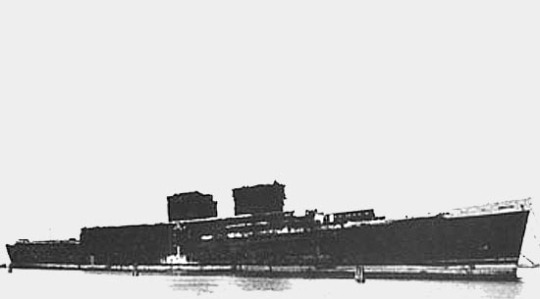
Here she is in a rather sorry state after her wreck was raised.
Anyway, here's some more pictures because she's a gorgeous liner.



She's number 26 because to me, a ships story is the most important aspect, and hers isn't all that remarkable compared to the others on the list.
#oceanliners#oceanliner#ocean liners#ocean liner#ss conte di savoia#conte di savoia#world war 2#world war ii#ss rex#rex
19 notes
·
View notes
Note
Have you come across any books or papers that explore or have interesting things to say on topics like aromatherapy, music therapy, or art therapy.. and whatever new something therapy there is?
I just thought you might know.. and thanks either way :D
yes a few :3 on historical origins and case studies. also hi sorry this has just been marinating in my inbox for like a week lol. just putting these in no particular order, there's stuff here on horticultural, occupational, music, gymnastic, light, and hydro-therapies. there is a really large body of literature on this type of topic in history and sociology of medicine though, these are just scratching the surface & mostly tilted toward british context because of the class i read them for lol
All the Aids that Nature Can Afford: Horticulture, Healing, and Moral Reform in a Gilded Age Hospital (2023). Linnea Kuglitsch. International Journal of Historical Archaeology 1.27 183–200, DOI 10.1007/s10761-021-00648-x
Shūzō Kure’s essay on psychotherapy including music in twentieth-century Japan (1916) (2022). Mitsuhira, Yuki. History of Psychiatry 33.3 364–373. DOI 10.1177/0957154X221098517
Showers: from a violent treatment to an agent of cleansing (2019). Cox, Stephanie C.; Hocking, Clare; Payne, Deborah. History of Psychiatry 30.1 58–76, DOI 10.1177/0957154X18801766
Work, Psychiatry and Society, c. 1750-2015 (2016). Ernst, Waltraud (ed.). ISBN 9781526109255
Perkins’s Patent Metallic “Tractors”: Development, Adoption, and Early Dissemination of an Eighteenth-Century Therapeutic Fad (2019). Lanska, Douglas J. Journal of the History of the Neurosciences 28.2 122–146, DOI https://doi.org/10.1080/0964704X.2019.1589830 (2-part article, 2nd part follows in same issue)
Soaking up the rays: Light therapy and visual culture in Britain, c. 1890-1940 (2017). Woloshyn, Tania Anne. ISBN 9781784995126
The Science of Automatic Precision: The Rise and Fall of Spectro-Chrome Therapy (2014). Lavine, Matthew. Historical Studies in the Natural Sciences 44, 140–177
Exercises in Therapy---Neurological Gymnastics between Kurort and Hospital Medicine, 1880--1945 (2014). Guenther, Katja. Bulletin of the History of Medicine 88.1 102–131, DOI 10.1353/bhm.2014.0022
‘He shall have care of the garden, its cultivation and produce’: Workhouse Gardens and Gardening, c.1780-1835 (2021). Collinge, Peter. Journal for Eighteenth-Century Studies 44.1 21–39, DOI 10.1111/1754-0208.12717
Murky waters: British spas in eighteenth-century medicine and literature (2022). Vasset, Sophie. ISBN 9781526159717
Work and Occupation in French and English Mental Hospitals, c.1918-1939 (2023). Jane Freebody. ISBN 9783031131073
22 notes
·
View notes
Text
Monkees Crash Course Part 1
@longing4yesterday was interested in getting some Monkees info SOOO I'm making a lore dump post. This is really just focused on their OG run as a foursome, so 1966-1969ish, stopping when Peter quit the band. I'll be posting a part 2 as well, Tumblr was getting pissed and won't post it altogether.
The Important Players

Davy Jones
December 30, 1945 – February 29, 2012
Personal History: Davy was born in Manchester. Initially he had dreams of becoming a jockey, but was encouraged to go into acting and eventually ended up in the role of the Artful Dodger in Oliver! This is ultimately what led him to moving to the USA and getting noticed for a role in The Monkees.
Role in The Monkees: There are effectively 2 lead singers of The Monkees. Davy is one, best known for singing 'Daydream Believer'. He's also the 'cute one', and was the one primarily marketed as being a heartthrob of the group. With his history in Broadway, he sings most of the songs that put focus on belting/projecting. Although Davy isn't particularly known for any instruments (in the show he's relegated to the maracas more or less) he is also an adept musician and could play the guitar and drums.
Personality: Davy has a bit of a duality to him. A health nut who smoked cigarettes. Sweet but scrappy. Kind but mean. Has the most noticeable ego about him: He was performing in Oliver! as the Artful Dodger on Ed Sullivan the same night as The Beatles. He watched them perform from the wings and later told Mike that he 'might like to do' what they did. Oodles and oodles of confidence! Witty and charismatic. He's probably all told the one who's the most critical of the other Monkees, though he also clearly has love for them. Some of this is obvious and sincere bitterness and some of this is having a biting, stereotypical 'British' sense of humor; there is insult even in quite a few of his lighthearted/joking comments about the other guys (i.e. calling Micky 'Skilletface' because he has a flat nose/looks like he's been smacked in the face with a skillet).
Davy fact: Davy continued his love of horses despite giving up on his jockey dreams, and in 1996 won his first race, on Digpast, in the one-mile Ontario Amateur Riders Handicap at Lingfield in Surrey.

Micky Dolenz
March 8, 1945 -
Personal History: Micky was a child actor on the TV show Circus Boy in the 50s. During that time he was a bit of a celebrity and would go to fairs to play guitar and sing Purple People Eater. Definitely had some social struggles as a result, as he was tutored/home schooled during this time, then skipped grades, then ended up repeating a year in high school when his psychiatrist told his mom he needed to work on connecting with kids his age. He was beginning to go to trade school to become an architect when he auditioned for The Monkees.
Role in The Monkees: Micky is the second lead singer/voice of The Monkees, best known for singing 'I'm a Believer'. Was effectively volunteered into being the drummer because no one else wanted to do it. However Micky is a very energetic showman, and Mike later reported that he offered to take up the drums himself so that Micky could 'get out there'. Due having Perthes disease as a child that left him with chronic hip pain, his drum setup is different so that he plays 'right handed' but 'left footed' to play the kick drum. Marketed as the 'funny/crazy' one.
Personality: Micky is bouncy, puppy-dog friendly, overly energetic and extroverted in public, but quieter and more thoughtful/interested in chemistry and building things in his downtime. Goofy/slapstick sense of humor. He's generally very positive/loving towards all of the other Monkees, and MUCH better at the PR of being diplomatic about the things that obviously left him bitter about the other guys than any of the other Monkees are. Very expressive and emotional. Definitely the one with the best social reputation of all the other Monkees, and has continued friendships/working relationships with a lot of the people he knew 'back in the day'.
Micky fact: Micky is part Chickasaw and in the late 60s he got a letter asking for help because 3 Native Americans had been arrested for fishing a lake that they had always used. He paid their bail (iirc something like $3000?) and received a painting in thanks.

Mike Nesmith
December 30, 1942- December 10, 2021
Personal History: Mike grew up in Texas. He was aimless for a while and joined the Air Force, but pretty quickly realized he'd made a mistake in joining and was fortunate enough to be able to get discharged. He worked as a hootmaster at the Troubadour and was struggling with a new family to support when he ended up getting cast on The Monkees.
Role in The Monkees: Guitar player. Song writer. Singer (when it came to country tunes) Within the TV show, Mike was effectively the leader of The Monkees, and this wound up being true in real life when he went to bat for their musical integrity.
Personality: During the run of The Monkees, Mike was often called 'The Smart Monkee', though this was never really meant positively. Surrealistic, dry sense of humor. Within the TV versions of themselves, Mike was often placed as a de facto leader of sorts. This is something that wound up carrying over into the real life world of The Monkees. Mike is the Monkee that definitely gets the most hate for reasons that are justified and reasons that aren't really. Mike was very strong willed and contrary and funny, and also very insecure. His insecurity led to him shooting himself (and the other Monkees) in the foot when it came to their public image pretty often, as well as tearing apart his relationships the same way.
Mike fact: Mike got super into World of Warcraft. He ended up reassessing after he had to go to work for a few days and came back online to messages wondering if he died.

Peter Tork
February 13, 1942- February 21, 2019
Personal History: Peter was born in Washington but moved to New York and was a part of the folk music scene in Greenwich Village. He was working as a dishwasher at the time he landed a role on The Monkees. After Stephen Stills was declined due to his crooked teeth, he recommended Peter for a role on The Monkees. Reportedly Mike also recommended Peter for a role due to his musical talent, as he was working as a dishwasher at the Golden Bear in Huntington Beach and was known around the local nightclub circuit.
Role in The Monkees: Within the show, Peter was classed as 'the dummy', but this wasn't true in real life. Outside of the show, Peter was the one who was able to play the most instruments. He was designated to the bass guitar since the others couldn't play it, and most often played piano or organ on the other songs (though the other Monkees did play piano on some of the tunes). He also taught Micky how to play the drums.
Personality: Peter was the one who got most into the 'hippie movement' in the 60s. Free loving, pot smoking, all that jazz. He was known as the 'orgy organizer' and often a nudist who had people floating in and out of his house at all hours of the day. He gave his money/items freely to a fault and was taken advantage of in this regard during The Monkees first run. He also ended up losing quite a bit of money due to breaking his contract to quit The Monkees-- all in all he was the most against capitalism but also likely the most negatively affected by it within the band due to his strong opinions and his willingness to give to others. Though The Monkees were all on the same page to varying degrees politically speaking, Peter was the most vocal about the political process and talked politics often. Peter was diagnosed quite late in his life as having autism.
Peter fact: Peter briefly worked as a teacher in the 70s teaching English, social studies and music at two private schools in the Los Angeles area.

Bert Schneider and Bob Rafelson
The guys behind The Monkees, created Raybert productions and produced some awesome shows an movies. Personally I don't have too much to say about these guys, though I think most Monkees fans hate their asses lol. The opinions on them as people are relatively mixed in general and from The Monkees themselves-- a mix of heated comments (both on personality and because of The Monkees being fucked over contractually) and gratitude. A lot of it depends on the decade you find the quote from. I do think they cared a lot more about money than any of The Monkees as people while pretending to care more than they did because they wanted to use The Monkees' own interests to cater to the crowd they were selling to.
Donnie Kirshner

Don Kirshner is 'The Villain' in The Monkees story. He was 'The Man With the Golden Ear' and was in charge of hiring songwriters and determining what songs got pumped out. The Monkees ended up booting Donnie and gaining more creative control.
Quote from The Wrecking Crew Facebook page:
"In the early 1960s, Kirshner was a successful music publisher as head of his own company, Aldon Music, which later was sold to Screen Gems-Columbia Music. . He later became president of COLGEMS, a subsidiary of the COLPIX label, in 1966.
Kirshner was hired by the producers of The Monkees to provide songs to accompany the television program. Kirshner used songwriting talent from his Brill Building stable of writers and musicians.
The formula worked phenomenally well – the singles "Last Train to Clarksville", written by Tommy Boyce and Bobby Hart, and "I'm a Believer" written by Neil Diamond and the first two Monkees albums were produced and released in time to catch the initial wave of the television program's popularity.
After a year, the Monkees wanted a chance to play their own instruments on the records. They also wanted more control over which songs would be released as singles. The matter reached a breaking point over a disagreement regarding the Neil Diamond-penned "A Little Bit Me, A Little Bit You" in early 1967. The song's release by Kirshner as a single without Columbia Pictures' consent, led to his dismissal."
Kirshner planning/releasing songs without The Monkees involvement led to a very explosive fight, most notably between Kirshner and Mike. This fight was documented in Micky's autobiography like this:
Cut To:
Int. Kirshner’s Bungalow — Night
The four Monkees, Donnie Kirshner, and Herb Moelis (a Screen Gems lawyer) are in attendance. The boys have just arrived and pleasantries have been exchanged. The atmosphere is tense. Everyone knows what’s coming, and no one is looking forward to it.
Micky is lounging in a chair, dreading the inevitable. Peter is standing against a wall with his arms folded. Davy is doing his nails. This time it’s Mike who’s pacing like a caged tiger.
Donnie has four Gold records stacked up on a table. He picks them up and hands them to the guys. He grins a big toothy grin.
DONNIE
So, here they are guys. Your sparkling new Gold records! Congratulations!
MICKY
(feinged enthusiasm)
Great!
DAVY
(feinged enthusiasm)
Great!
PETER
(no enthusiasm)
Hummph!
MIKE
(ominously)
When is the next release scheduled?
DON
Well… we think it should be in late February… or so.
PETER
(sarcastically)
Well, guys. I guess we better get into the studio and start recording some new tunes. Our tunes.
Donnie’s big toothy grin starts to fade. All you can see now are the tips of his fangs.
DONNIE
No, no. Don’t bother, We’ve already recorded some great new tracks in New York. There’s this one unbelievable tune by Neil Diamond… You remember him, he wrote “I’m a Bel…”
MIKE
(exploding)
What! You recorded new tracks in New York? Why the hell didn’t you talk to us first? It’s our names going on those records!
Whatever was left of the big toothy smile is gone and lost forever. It has been replaced by a thin, grim smirk.
DONNIE
Take it easy, kid. Why don’t you just be happy with this Gold record and…
MIKE
Look! Either we get total and complete control of all the recording and the releases or I’m quitting!
Donnie is taken aback; the grim grin is frozen on his face. Even the other three guys are stunned. No one thought it would come to this. And no one thinks Mike is bluffing. Mike doesn’t bluff. Suddenly, Herb Moelis, the lawyer, speaks up.
MOELIS
(arrogantly)
You’d better take a look at your contract, son. You can’t quit unless we tell you you can quit.
Big mistake! This is not something you tell Mike Nesmith, even as a joke, on a good day. Mike spins around to confront the squirmy legal beagle. There is fire in his eyes and a fury in his heart. His fists are clenched. The veins are popping out of his neck. He looks like he is about to explode all over this little litigator. Somehow he manages to maintain his self control..
He turns to the nearby wall, cocks back his fist, and plunges it into the thirty-year-old lath and plaster.
MIKE
THAT COULD HAVE BEEN YOUR FACE, MOTHERFUCKER!
With that he storms out of the seething room and into the cool LA night.
Fade out
To say the least, The Monkees didn't like Kirshner much.
Quotes from Don Kirshner on The Monkees:
Don Kirshner on The Monkees…
ON MIKE NESMITH: Though people say that Mike doesn’t talk much, he is actually very articulate. My wife Sheila and I spent a long evening in a quiet Hollywood restaurant having dinner with Mike and his wife Phyllis when I first met them. I noticed that he had a particular passion for salads. He told me about one salad that he makes with nuts in it. I had never had that, and I tried it later and it was quite good. Mike is very witty, and he told us a funny story about the time he literally jumped over a general’s airplane when he was in the Air Corps. He has the kind of humor that Andy Griffith has, but his style is unique and his very own. Phyllis is one of the sweetest girls Sheila and I have ever met. She is very friendly, very much a wife – and she adores Mike.
ON PETER TORK: I would say that Peter is the deepest of the boys. He is very literate – and he is concerned about motivation and justification. He likes to have serious conversations about music and other things. He always goes beneath the surface. Oddly, in contrast to his seriousness, he is one of the funniest young men I have ever met. He is also one of the finest guitar players I have heard around in a long, long time. Basically, he has a lot of warmth and sincerity, and he is very dedicated in all that he does.
ON MICKY DOLENZ: Micky is one of the most completely amusing and charming boys I’ve ever met. His great sense of humor surrounds him with a kind of aura of joy. Being with Mick makes you feel happy inside. He’s one of the most versatile singers I’ve heard. He has lots of drive, and his anxiety about putting out a perfect record pushes him to peaks of excellence. There just isn’t enough time for Micky to do everything he wants to do. He is always jumping around. I call him perpetual motion. He loves action and he picks up on everythings [sic] very fast.
ON DAVID JONES: I have known David for a long time and have had the rewarding pleasure of watching his career grow over the past several years. I have also been able to watch him grow as a person, and I am very pleased with the way David is maturing and developing, both as a performer and as a human being. David spent last Thanksgiving at our house and I realized how very family-conscious he is. He talks about his folks a lot and takes great care of his dad and family. He and David Pearl are close friends and it is a pleasure to be in their company. They are both very fine young men. David Jones knows where he is going. He is precise and he is very experienced for his age – in all areas. He is a loyal friend, and I know that no matter what rewards he may reap, his first concern will always be doing things for others. I consider David a close friend.
I'm including these because I think it gives a good idea of Don Kirshner's view. Even the compliments largely aren't complimentary and are rather condescending, backhanded compliments like 'literate' or 'articulate' that are more negative than they might be taken on their face.
The TV Show

As a quote from Stephen Stills: The casting ad for “The Monkees," The Hollywood Reporter, September 8, 1965. "I was just starting out as a songwriter and I had about 8 or 10 songs and they were so simple I thought they would be perfect. I just wanted to sell my songs. When I got in there I told Bob Rafelson and Bert Schneider that I knew a guy who would be perfect. His name was Peter Torkelson."
Initially it seemed like the show wasn't going to be picked up. At its first pitch it was more formulaic to the time: There was a 'fatherly' role which ended up being cut, and was closer in tune with Leave it to Beaver type sensibilities. It was repackaged by Bert and Bob to be more improvised and more about the 4 boys on their own struggling to make it as a band without 'adult' authority.
The show lasted 2 seasons on NBC. It was an episodic show with no overarching plot beyond the idea that there's a band that's struggling to make the rent. The characters all share the names of the real life Monkees, so Mike Nesmith, Micky Dolenz, Davy Jones, and Peter Tork are the Monkees both in real life and on the show. Unique in that the four were taught improv techniques and were encouraged to improvise lines. Also unique in that there were 'Monkee Romps' which were in their way music videos where it was just the boys playing or running around while one of their songs played.
Monkees Screen Tests - About 20 mins of the boys as they try to land the role :)
Google Drive with all the episodes
Google Drive with all eps + DVD commentary tracks by the Monkees
TV show/music controversy:
So because The Monkees were a TV show band that became a real band, there was push-back that they weren't singing their own songs, that they weren't playing their own instruments, that they weren't actually a real band. They had hired song-writers like Boyce and Hart, they had guys like Don Kirshner who was specifically trying to make them marketable, they had The Wrecking Crew, pictured below, who were studio musicians-- so a lot of what was being done on their part was singing the vocals.

But at its core this is something that's a bit odd. The Wrecking Crew played on records of 'real' musicians. The Byrds, Buffalo Springfield, and many, many others, all utilized The Wrecking Crew to play on their albums. Even early on Mike was contributing to song-writing. And The Monkees played live almost immediately. Though their first stint was in promotion for the show and was a flop-- they played The Last Train to Clarksville on a moving train and as a result they and their instruments were being thrown all over-- they were very quickly able to functionally play as a band live. By their tour in 1967, they actually pretty largely got good reviews published in the paper; the 'bad' reviews were often more in the line of 'they can't be heard over the screaming children'. But if you go through newspapers at the time in the places they played, there's plenty of positive comments even outside of their audience--that is, middle aged men versus teen girls-- saying they were actually pretty good. So what's the deal?
Honestly a lot of it is probably The Monkees themselves, especially Mike himself. One member of the band the Association told The Wrecking Crew that the musicians' names wouldn't be on the record because "We don't want kids to know we didn't play on the record.". While there was some hiding of the fact it wasn't The Monkees playing, it didn't take long before The Monkees themselves were commenting on this. And Mike was the big dissenter on it.
Here's one comment from Micky in Minnesota in 1967:
Well interesting for me. As most of you have undoubtedly heard, it has been-- there's been a lot of hassle and everything about the Monkees playing our own music and, uh...Which took us quite by surprise. Since we we do and we did, and uh...The first the first records the first songs the first album anything we were just jamming together with a whole lot of people, trying to just put together anything, music whatever and then they came out and then everybody started criticizing us for not playing all the violins and not all the saxophones and not the 85 other instruments involved in making a big track or making big tracks or whatever, you know and rather than like learn how to play the French horn. We would call him a very expert French horn player. Like Vince Groza, for instance, who's like about the best, and have him do it but the wrath of Hell went down upon The Monkees and we all got together we all meaning just us four and just said and decided that for our own peace of mind and especially because people just didn't seem to understand we would transgress which means go backwards which is what we did in fact and pick up three guitars and a set of drums and say well if this is what you want, okay, we can do a lot of groovier things with other instruments, but whatever. It wasn't quite that deep or anything. Or that heavy.
But when we ended up having a lot of fun doing it. And the record that I'm gonna play now good bad or indifferent, you can judge yourself, is the first record the first really complete song that is just us four. We were really mad. We didn't even have an engineer in the booth or a producer. Nobody. We recorded it on a little Sony transistor tape recorder in a bathroom to get a groovy sound because we figured well if that's what they want to hear and they really are uptight about us not really doing it. We all sat down and concentrated on our energies and trying to come up with a foursome sound just out of our own thing and now we're back into you know, like doing things with electronic instruments. I have a electronic instrument set up, you know doing those kind of things and we're using, you know groovy guitar players and groovy horn players and groovy this players and groovy that players to get all kinds of different sounds and uh...But this is like in case none of you knew the first, you know, honest to goodness kind of Monkees song and it's really bad. I mean compared to other foursome sounds I think you know because we had like I think three or four hours a night for about a week to do it. Which is not a very long time at all, especially after you finished working on the set and we'd all run to the studio, just thrashed and wiped out and but determined to put out a record I really know just a song, you know our first song.
youtube
This is the song he is referring to.
Apparently the bathroom got good acoustics cuz it's not the only song they recorded in the bathroom for

Anyway....Micky's comment is, while hurt and emotional and marginally self-deprecating, relatively diplomatic: The Monkees are getting a lot of hate for not playing their own instruments. And yeah, they do hire outside musicians, because they're working 12-16 hour days shooting the show, and going on tour, and doing their own recording for the music with the vocals if nothing else, so if they did it all it's going to be rushed and it's not going to be as good as they could do it with 50 hired musicians. But they had a lot of fun recording their own music for Headquarters (the first album that was 'theirs' in terms of recording the sound/song choice/etc) and hopefully it still is a song their fans like.
Mike by contrast, also in Minnesota, told the newspaper that The Monkees weren't anything good and that they were pretty much just a stepping stone for the kids to get into real, adult music. Even when they were actively working on putting out their own music, Mike was putting out statements that was effectively that they were little kiddie music for babies.
This isn't to say it was all Mike's fault. (Probably). Songs like So You Want to Be a Rock and Roll Star by The Byrds were supposedly a swipe at The Monkees. Was this true, especially considering The Byrds, like I said, also used The Wrecking Crew? Including to the point that they largely didn't contribute to the music themselves on their first hit, Tambourine Man? Who knows. Peter at least told Rolling Stone that he'd never heard that:
No. Nobody ever said anything like that to me. I took it at face value. Maybe they thought about the Monkees, but “Get a guitar and learn how to play…” Michael and I had been playing…I’d been playing music of one sort or another from the time I was nine years old, when I began to take piano lessons. So that was for 14 years. Michael had been playing continuously for several years before that; he was a folki e. Micky played folk guitar, fireside guitar — you gave him a guitar, and he could play anything. Davy, who didn’t play any instruments, had been on Broadway. He was the American original Artful Dodger in Oliver, and that’s not nothing as a musical ability. Davy, too, when we said, “We need a bass player for this,” he said, “How do I play bass?” We said, “You put your finger here, and you pluck this string here at this moment,” and he was onstage with us playing bass in five minutes. He knew. Davy is one of the most fabulously musically adept minds I have ever met. You just don’t…that’s not nothing.
and they were also getting thanks on the albums of 'real' musicians like Buffalo Springfield:

So I don't know. While there was criticism in this regard, frankly a lot of it from the press was also eye rolling at the fact that the demographic for The Monkees was young girls and 'long-haired' people. There were also criticisms of drug references, what have you. The demographic plus the fact that The Monkees were primarily actors first, plus the fact they were 'hippies', plus the fact that Mike ESPECIALLY would run his mouth about these things really did nothing for The Monkees' public persona. This was also exacerbated that they got a bit of a 'diva' rep especially early on because Bob and Bert didn't want them to answer hard-hitting interview questions so that they wouldn't lose their mainstream appeal by getting political. There are articles of The Monkees 'refusing' to talk to the press; at the same time there are articles talking The Monkees up because they go out of their way to interact with their fans in ways that big names (including The Beatles) didn't. And there's quite a bit of positive press that they actually play well, that they shine when they're doing their solo and give a show worth the price of admission, etc.
While the reflection of what the press thought about The Monkees is often boiled down to digs about them not playing their own music, it was actually much more of a mixed bag at the time. And it was often exacerbated by The Monkees themselves, especially Mike running his mouth about it. Later on The Monkees by and large settled into seeing themselves as a 'fake band', that is, a 'television band', or maybe a 'band of actors', but in a way that is more positive than how they broached it in the 60s. The holdout on this stance was pretty much Peter, who seemed more in the vein of if they are capable musicians then the music is real, regardless of if they were only playing it because they were hired 'actors'. I personally tend to agree more with Peter's perspective of seeing them as both actors and a 'real' band than the other perspective of being actors who were hired to play music (despite the technical truth of the latter).
15 notes
·
View notes
Text

William Rothenstein (British, 1872-1945), Blasted Trees (blue version). Oil on canvas, 98 x 81 cm. Cartwright Hall Art Gallery, Bradford, West Yorkshire
98 notes
·
View notes
Text

Sir John Newenham Summerson
Artist: Leonard Rosoman (British, 1913-2012)
Date: 1984
Medium: Oil on canvas
Collection: National Portrait Gallery, United Kingdom
Sir John Newenham Summerson
Architectural historian and writer on art. Sir John Summerson typified the professional mandarinate that dominated government and the arts after the Second World War. Educated at Harrow and the Bartlett School of Architecture, Summerson turned to writing about architecture in the early 1930s under the pseudonym 'Coolmore'. He later wrote a number of books including Architecture Here and Now (1934), Georgian London (1946), Ben Nicholson (1948) and The Life and Work of John Nash, Architect (1981). In 1945 he became Curator of Sir John Soane's Museum in Lincoln's Inns Fields and remained in this post until his retirement in 1984, aged 80.
Leonard Rosoman painted Summerson in Sir John Soane's Museum shortly before his retirement in 1984.
#portrait#painting#indoor scene#museum#sir john newenham summerson#architectural historian#artwork#oil on canvas#art#statue#table#suit and tie#standing#full length#british#british culture#british art#leonard roseman#british painter#oil painting#20th century painting
16 notes
·
View notes
Text
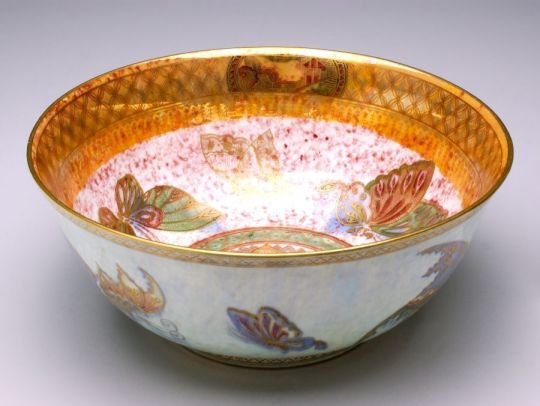
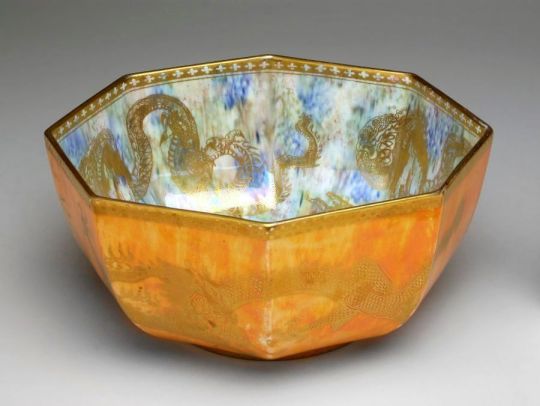
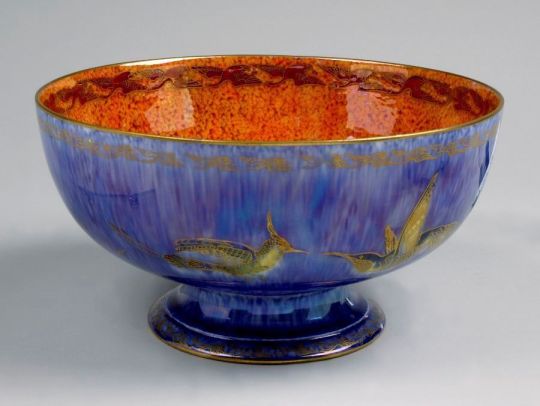
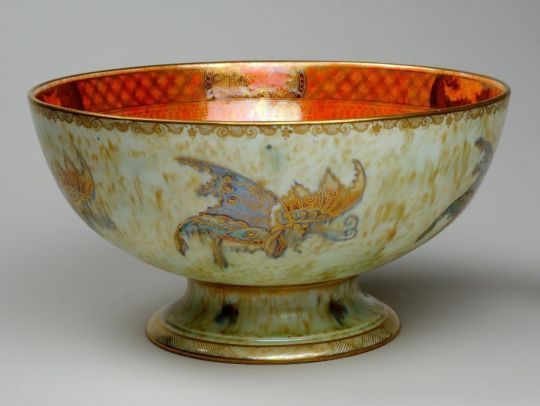
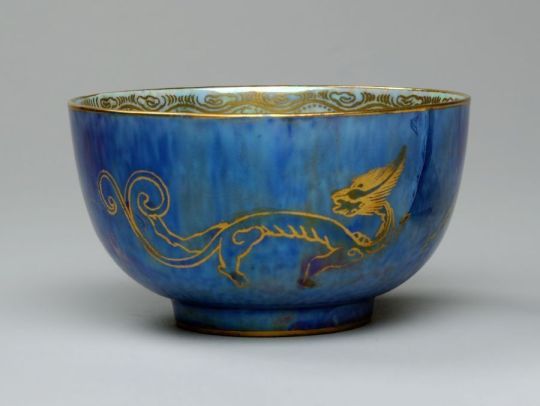
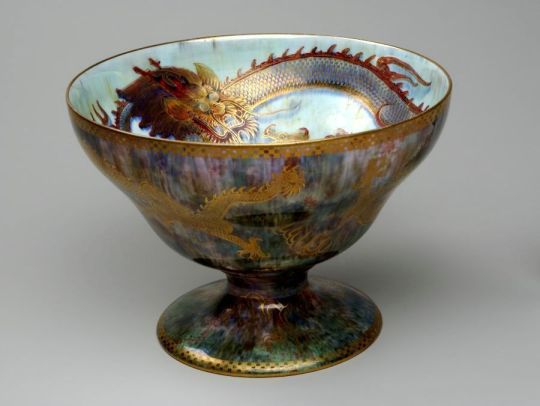


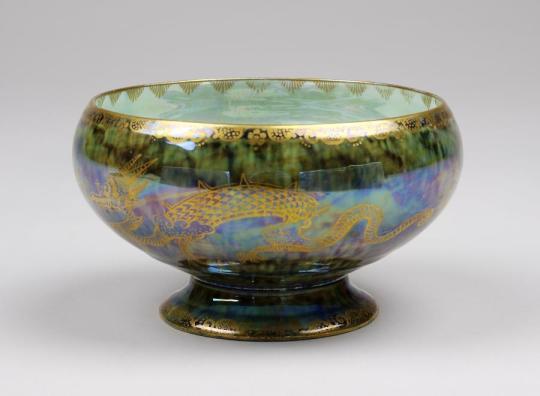


Bowls (circa 1914-1931) by Daisy Makeig-Jones (British, 1881–1945) for Josiah Wedgwood & Sons Ltd.
Bone china with lustre glaze.
Images and text information courtesy Carnegie Museum of Art.
222 notes
·
View notes
Text

... stained glass ...
Stained glass window in Art Nouveau style from 1901 by British architect and artist Mackay Hugh Baille-Scott (1865-1945).
📷 Daderot
#stained glass#window#art nouveau#mackay hugh baille scott#british architect#flowers#flower power#artwork#daderot
25 notes
·
View notes